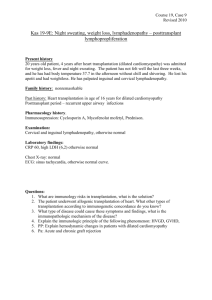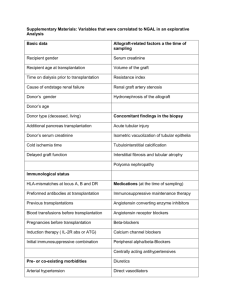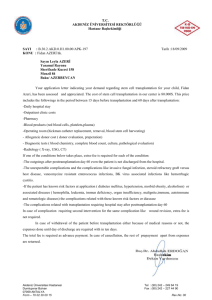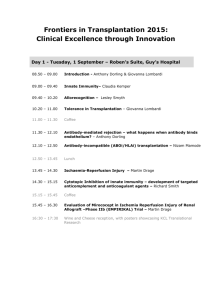transplantation
advertisement
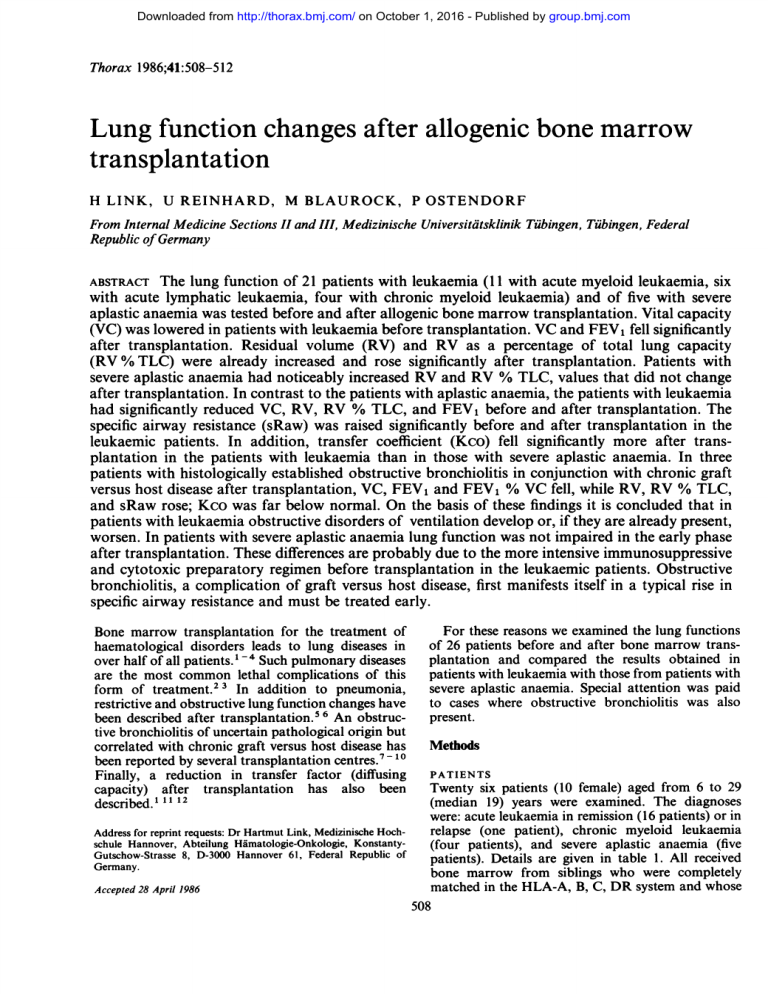
Downloaded from http://thorax.bmj.com/ on October 1, 2016 - Published by group.bmj.com Thorax 1986;41:508-512 Lung function changes after allogenic bone marrow transplantation H LINK, U REINHARD, M BLAUROCK, P OSTENDORF From Internal Medicine Sections II and III, Medizinische Universitatsklinik Tubingen, Tubingen, Federal Republic ofGermany ABSTRACT The lung function of 21 patients with leukaemia (11 with acute myeloid leukaemia, six with acute lymphatic leukaemia, four with chronic myeloid leukaemia) and of five with severe aplastic anaemia was tested before and after allogenic bone marrow transplantation. Vital capacity (VC) was lowered in patients with leukaemia before transplantation. VC and FEV, fell significantly after transplantation. Residual volume (RV) and RV as a percentage of total lung capacity (RV % TLC) were already increased and rose significantly after transplantation. Patients with severe aplastic anaemia had noticeably increased RV and RV % TLC, values that did not change after transplantation. In contrast to the patients with aplastic anaemia, the patients with leukaemia had significantly reduced VC, RV, RV % TLC, and FEV1 before and after transplantation. The specific airway resistance (sRaw) was raised significantly before and after transplantation in the leukaemic patients. In addition, transfer coefficient (Kco) fell significantly more after transplantation in the patients with leukaemia than in those with severe aplastic anaemia. In three patients with histologically established obstructive bronchiolitis in conjunction with chronic graft versus host disease after transplantation, VC, FEV, and FEV, % VC fell, while RV, RV % TLC, and sRaw rose; Kco was far below normal. On the basis of these findings it is concluded that in patients with leukaemia obstructive disorders of ventilation develop or, if they are already present, worsen. In patients with severe aplastic anaemia lung function was not impaired in the early phase after transplantation. These differences are probably due to the more intensive immunosuppressive and cytotoxic preparatory regimen before transplantation in the leukaemic patients. Obstructive bronchiolitis, a complication of graft versus host disease, first manifests itself in a typical rise in specific airway resistance and must be treated early. Bone marrow transplantation for the treatment of haematological disorders leads to lung diseases in over half of all patients.`1 Such pulmonary diseases are the most common lethal complications of this form of treatment.23 In addition to pneumonia, restrictive and obstructive lung function changes have been described after transplantation.56 An obstructive bronchiolitis of uncertain pathological origin but correlated with chronic graft versus host disease has - o been reported by several transplantation centres.71 Finally, a reduction in transfer factor (diffusing capacity) after transplantation has also been described.' 11 12 For these reasons we examined the lung functions of 26 patients before and after bone marrow transplantation and compared the results obtained in patients with leukaemia with those from patients with severe aplastic anaemia. Special attention was paid to cases where obstructive bronchiolitis was also present. Methods PATIENTS Twenty six patients (10 female) aged from 6 to 29 (median 19) years were examined. The diagnoses were: acute leukaemia in remission (16 patients) or in relapse (one patient), chronic myeloid leukaemia Address for reprint requests: Dr Hartmut Link, Medizinische Hochschule Hannover, Abteilung Hamatologie-Onkologie, Konstanty(four patients), and severe aplastic anaemia (five Gutschow-Strasse 8, D-3000 Hannover 61, Federal Republic of patients). Details are given in table 1. All received Germany. bone marrow from siblings who were completely matched in the HLA-A, B, C, DR system and whose Accepted 28 April 1986 508 Downloaded from http://thorax.bmj.com/ on October 1, 2016 - Published by group.bmj.com Lung function changes after allogenic bone marrow transplantation 509 Table 1 Clinicalfeatures of 26 patients treated by allogenic bone marrow transplantation (BMT) ALL AML No of patients Total body irradiation 3 Gy 10Gy 5 x 2.5Gy GvHD prophylaxis Methotrexate Cyclosporin A Acute GvHD 0-I II-IV Chronic GvHD Limited Extensive Lung disease after BMT I CR 2 CR PRIRel 2 CR 3 CR Rel 5 5 1 3 1 2 4 1 1 3 4 4 I 1 2 3 1 2 1 BFOV*/ F/F IF/BR/ BF 5 Total CP Acc 3 1 2 5 1 I CML SAA 26 2 15 6 2 2 1 2 1 1 1 2 3 1 3 1 I 3 1 3 12 5 2 1 B 3 6 BOV*/ OV* I I IF 1 F* 1 1 1 16 9 F 1 3 3 2 Relapse after BMT 9 *Fatal outcome; patients with two or more symbols had more than one episode of pulmonary disease. GvHD-graft versus host disease; AML-acute myeloid leukaemia; ALL-acute lymphoblastic leukaemia; CR-complete remission; PR-partial remission; Rel-relapse; SAA-severe aplastic anaemia; CML-chronic myeloid leukaemia; CP-chronic phase; Acc-accelerated phase. Lung diseases: B-bacterial pneumonia, F-fungal pneumonia; V-viral pneumonia; 0-obstructive bronchiolitis; IF-pulmonary infiltrate of unknown origin; BR-bronchitis. Conversion: SI to traditional units-Radiation dose: 1 Gy = 100 rads. lymphocytes gave no reaction in mixed lymphocyte culture. CONDITIONING AND BONE MARROW TRANSPLANTATION Patients with leukaemia were given two doses of cyclophosphamide 60mg/kg body weight to destroy leukaemic cells and to produce immune suppression. They also received total body irradiation of 1OGy (1000 rads) or five fractions of 2.5 Gy. The dose to the lung was reduced to 8 or 1O Gy. The dose rate was 7cGy(rads)/min. Patients with severe aplastic anaemia were treated with four doses of cyclophosphamide 50mg/kg for immunosuppression; two patients also received total body irradiation of 3 Gy. Immediately after transplantation all of the patients were isolated for four weeks in laminar airflow units with total enteral and topical decontamination to prevent infections. All received co-trimoxazole (30 mg/kg a day) orally as prophylaxis against Pneumocystis carinmi infection. Prophylaxis against graft versus host disease was undertaken with methotrexate or cyclosporin A and in patients with leukaemia the marrow was also incubated with anti-human thymocytoglobulin. 3 Details of conditioning and graft versus host disease prophylaxis are given in earlier publications.1 8 14 LUNG FUNCTION TESTS Before transplantation and one to six months thereafter static and dynamic lung volumes were determined by means of body plethysmography (Fenyves and Gut) and the following indices were determined: inspiratory vital capacity (VC), residual volume (RV), thoracic gas volume (TGV), total lung capacity (TLC), RV % TLC, FEVI, FEV, % VC, maximal breathing capacity (MBC), airway resistance (Raw), and specific airway resistance (sRaw). Transfer factor for carbon monoxide (TLCo) and transfer coefficient (Kco) were measured by the single breath method. The measurements are given as percentages of the normal values published by Ruhle and Matthys (1976)'" for static and dynamic lung volumes. The reference values for TLCO were obtained in our own lung function laboratory. '6 STATISTICAL METHODS The measurements before transplantation and those taken one to six months afterwards were grouped together. Group means were compared with Student's t test for dependent and independent random samples, with a significance level of 5% for the two sided test. Results PATIENTS WITH LEUKAEMIA Results obtained in patients with leukaemia are shown in table 2. Vital capacity was reduced even before bone marrow transplantation and fell significantly (p < 0.01) after transplantation. RV and RV % TLC were noticeably raised before transplantation and increased significantly afterwards (p < 0.05 and 0.01). FEV, fell significantly (p < 0.05). sRaw was higher than normal before transplantation but did not rise Downloaded from http://thorax.bmj.com/ on October 1, 2016 - Published by group.bmj.com 510 afterwards to any significant degree. Kco was reduced after transplantation, but the reduction did not reach statistical significance. These values show that after transplantation airway obstruction and pulmonary hyperinflation increased even further. If the three patients with obstructive bronchiolitis after transplantation are excluded from the analysis of the patients with leukaemia, a comparison of values before and after transplantation yields the following: VC fell significantly (p < 0.01), RV % TLC increased significantly (p < 0.01), Raw fell significantly (p < 0.05), and TLCO fell significantly (p < 0.05). RV rose and FEV1 fell slightly after transplantation but the changes were not significant. PATIENTS WITH LEUKAEMIA DEVELOPING OBSTRUCTIVE BRONCHIOLITIS Link, Reinhard, Blaurock, Ostendorf specific granulation tissue or by fibrous scar tissue. The bronchial and bronchiolar walls were so severely inflamed that they were often barely recognisable as such. The lung tissue was scarred over extensive regions (indurated atelectasis) and was emphysematous in other parts. Of all our patients so far, four patients with chronic and one with acute graft versus host disease developed obstructive bronchiolitis between seven weeks and eight months after transplantation. The chest radiograph in three of the patients showed pronounced pulmonary hyperinflation and recurrent pneumothorax with distinct cutaneous emphysema. The capillary oxygen tensions fell to 50-70mm Hg (6.7-9.3 kPa). Pseudomonas aeruginosa, Proteus mirabilis, non-haemolytic streptococci, Serratia marcescens, Citrobacter freundii, and enterococci were detected in the cultures of sputum or bronchial secretions. Indices of pulmonary function for three patients (one acute and two chronic myeloid leukaemia) with histologically established obstructive bronchiolitis after transplantation in conjunction with chronic Obstructive bronchiolitis after transplantation was associated with acute or chronic graft versus host disease and characterised by increasing dyspnoea, cough, cyanosis, and pulmonary hyperinflation. Histological studies showed extensive obstruction of the lumina of the small bronchi and bronchioles by nonTable 2 Results of lungfunction tests before and after bone marrow transplantation in patients with leukaemia and severe aplastic anaemia (mean values with standard deviation in parentheses) n Leukaemia % of normal values Before n Aplastic anaemia % of normal values After Before After 92 (4) 66 (16)* 5 77 (13) 90 (5)t 164 (60) 4 161 (23) 152 (69) 123 (24) 4 253 (67)t 237 (126) 254 (138)** 174 (55) 180 (42) 4 192 (37)t 228 (61)* 177 (47) 126 (28) 127 (11) 4 104 (32) 96 (15) 118 (17) 5 109 (14)t 75 (25)** 88 (17) FEVY 126 (19) 122 (15) 108 (18) 5 114(12) FEV, % VC 4 88 (38) 82 (40) 123 (79) 122 (22) Raw 116 (55) 4 125 (44)$ 187 (153) 156 (36) sRaw 73 2 69(17) 77 (12) 56t Kco < and after between values before transplantation. for 01 difference 0 *p **p < 0 05 for differences between values before and after transplantation. tp < 0.001 for difference before transplantation between patients with leukaemia and with aplastic anaemia. $p < 0.01 for difference before transplantation between patients with leukaemia and with aplastic anaemia. VC-vital capacity; TGV-thoracic gas volume; RV-residual volume; RV % TLC-RV as % of total lung capacity; TLC-total lung capacity; Raw-airways resistance; sRaw-specific airways resistance; Kco-transfer coefficient. VC TGV RV RV % TLC TLC 21 18 18 18 18 21 21 17 17 10 Table 3 Results of lung function tests in three patients with leukaemia treated by bone marrow transplantation and developing histologically proved obstructive bronchiolitis (included in table 2) (percentages ofpredicted normal values) B (No 28) A (No 12) Diagnosis/age (y) AML/27 Patient Before VC TGV RV RV % TLC TLC FEV1 FEV1 % VC 65 130 206 203 99 61 94 123 160 Raw sRaw Kco Abbreviations as in tables I and 2. After 50 142 263 253 103 44 89 228 323 58 Mean values C (No 47) CML/1S CML acc/22 Before After Before After Before After 103 148 130 110 106 133 130 107 159 49 198 316 277 103 40 81 362 715 65 67 90 160 184 87 79 117 139 126 59 59 121 227 240 95 55 92 167 201 60 78 123 165 166 97 91 114 123 148 53 154 269 257 100 46 87 252 413 61 - - Downloaded from http://thorax.bmj.com/ on October 1, 2016 - Published by group.bmj.com Lung function changes after allogeneic bone marrow transplantation 511 graft versus host disease are shown in table 3. The fibrosis and restrictive losses in function.'8 In convalues before and after transplantation showed an trast to the patients with severe aplastic anaemia, the increase in pulmonary hyperinflation and airway leukaemic patients showed significant lowering of obstruction in all of the patients; there was a decrease VC, RV, RV % TLC, and Kco before transin VC, FEV1, and FEV1 % VC, an increase in RV, plantation, while sRaw was significantly raised. In and RV % TLC and an extreme elevation in sRaw. contrast to the leukaemic patients, the patients with Measurements of Kco were made after trans- aplastic anaemia appeared to have appreciable pulplantation but not before. The results were clearly monary hyperinflation but no substantial obstruclower than normal. tion. After transplantation the leukaemic patients' VC and FEV1 decreased while RV and RV % TLC PATIENTS WITH SEVERE APLASTIC ANAEMIA increased significantly. The changes in lung volumes are the result of a further increase in bronchial (table 2) RV and RV % TLC were appreciably raised even obstruction. Similar findings after transplantation before transplantation and did not fall substantially have been reported by others.56 The comparison with afterwards. The other indices showed no change, the patients with aplastic anaemia shows the suggesting that pulmonary hyperinflation was present differences that already existed before transbefore and after transplantation with no change. plantation, as well as significantly raised sRaw and significantly lowered Kco in patients with leukaemia. COMPARISON BETWEEN PATIENTS WITH One important factor leading to this difference is LEUKAEMIA AND WITH SEVERE APLASTIC likely to be the total body irradiation given to the ANAEMIA leukaemic patients before transplantation, since the The following pre-transplantation measurements other measures connected with transplantation were (table 2) were significantly lower in patients with leu- similar for the two groups of patients. Possibly total kaemia than in those with severe aplastic anaemia: body irradiation causes damage to the alveolarVC, RV (p < 0.001), RV % TLC (p < 0.01), FEV, endothelial membrane, which could contribute to (p < 0.01), and Kco (p < 0.001). sRaw was reduction in transfer factor-as has been postulated significantly higher (p < 0.01). Thus before trans- by other authors who have found lowered TLCO after plantation patients with leukaemia had less severe transplantation." 12 pulmonary hyperinflation but more severe airway So far, we have been able to test lung function in obstruction than those with severe aplastic anaemia. three patients with obstructive bronchiolitis after There was no difference in TLCO between the two transplantation. All three patients showed changes groups before transplantation. After transplantation indicating an obliterative process in the small pulmonary hyperinflation and obstruction increased airways. Similar changes have been found by further in the leukaemic patients, which made the others.9 10 19 20-23 All of the patients observed in differences between the two groups even greater. Tubingen with obstructive bronchiolitis (five Comparison between the two groups of the post- patients-two of them are not mentioned in this transplantation values of VC, RV, RV % TLC, and study) also had acute or chronic graft versus host dissRaw showed highly significant differences ease, an association confirmed by others.7 - 10 19 - 23 (p < 0.001). In a large scale series in Seattle no association between graft versus host disease and obstructive lung Discussion disease was found, but the patients with features of obstructive defects of lung function examined more The present study shows a striking difference between than four years after bone marrow transplantation patients with leukaemia and those with severe aplastic usually also had chronic graft versus host disease.5 21 anaemia. Even before bone marrow transplantation Probably we need to distinguish between the modthe leukaemic patients had more pulmonary hyper- erate obstruction after transplantation that usually inflation with greater than normal residual volume occurs in leukaemic patients and obstructive bronchiand lower than normal vital capacity. Specific airway olitis, which can be histologically established and resistance was likewise increased. These findings indi- which according to all the data so far published cate the presence of bronchial obstruction, the cause occurs only in conjunction with graft versus host disof which has not been established. One conceivable ease. The pathogenesis of these latter bronchial and cause could be the cytostatic chemotherapy17 to bronchiolar obstructions is still unclear. A connection which all of the patients with leukaemia were subjec- with chronic graft versus host disease is likely since ted in the course of primary treatment. Usually, how- this late complication triggers a fibrotic process in ever, chemotherapy has been cited as the cause of several organs and shows some similarities to autointerstitial pulmonary changes with subsequent immune diseases,24 such as systemic sclerosis, sys- Downloaded from http://thorax.bmj.com/ on October 1, 2016 - Published by group.bmj.com 512 temic lupus erythematosus, and Sj6gren's disease. Obstructive bronchiolitis can also occur as a complication of these autoimmune diseases. 1 7 On the basis of these results we conclude that patients with leukaemia receiving total body irradiation develop obstructive ventilatory disorders. The lung function of patients with severe aplastic anaemia, by contrast, is only slightly impaired in the first six months after transplantation. Particular attention must be paid to the development of bronchiolar obstruction in patients with graft versus host disease, since obstructive bronchiolitis may be a manifestation of graft versus host disease. In view of the poor prognosis of this complication, immediate treatment with immunosuppressants is indicated in such cases.7 9 16 18 References 1 Link H, Ostendorf P, Wernet P, et al. Pulmonary complications after allogeneic bone marrow transplantation. The Tubingen experience. Exp Hematol 1984;12,suppl 15:21-2. 2 Bortin MM, Gale RP, Kay HEM, Rimm AA. Bone marrow transplantation for acute myelogenous leukemia. Factors associated with early mortality. JAMA 1983;249:1166-75. 3 Buckner CD, Meyers JD, Springmeyer SC, etal. Pulmonary complications of marrow transplantation. Review of the Seattle experience. Exp Hematol 1984;12,suppl 15:1-5. 4 Winston DJ, Ho WG, Champlin RE, Gale RP. Infectious complications of bone marrow transplantation. Exp Hematol 1984;12:205-15. 5 Springmeyer SC, Flournoy N, Sullivan KM, Storb R, Thomas ED. Pulmonary function changes in long-term survivors of allogeneic marrow transplantation. In: Gale RP, ed. Recent advances in bone marrow transplantation. New York: AR Liss, 1983:343-53. 6 Serota FT, August CS, Koch PA, Fox W, D'Angio GJ. Pulmonary function in patients undergoing bone marrow transplantation. Med Pediatr Oncol 1984;12:137-43. 7 Kurzrock R, Zander A, Kanojia M, et al. Obstructive lung disease after allogeneic bone marrow transplantation. Transplantation 1984;37: 156-60. 8 Link H, Reinhard U, Niethammer D, Kruger GRF, Waller HD, Wilms K. Obstructive ventilation disorder as a severe complication of chronic graft versus host disease after bone marrow transplantation. Exp Hematol 1982;10,suppl 10:92-3. 9 Roca J, Granena A, Rodriguez-Roisin R, Alvarez P, Link, Reinhard, Blaurock, Ostendorf 10 11 12 13 14 15 16 17 18 19 20 21 22 23 24 Agusti-Vidal A. Fatal airway disease in an adult with chronic graft versus host disease. Thorax 1982;37:77-8. Wyatt SE, Nunn P, Hows JM, et al. Airways obstruction associated with graft versus host disease after bone marrow transplantation. Thorax 1984;39:887-94. S0rensen PG, Ernst P, Panduro J, Moller J. Reduced lung function in leukemia patients undergoing bone marrow transplantation. Scand J Haematol 1984;32:253-7. Depledge MH, Barrett A, Powles RL. Lung function after bone marrow grafting. Int J Radiat Oncol Biol Phys 1983;9: 145-51. Rodt H, Kolb HJ, Netzel B, etal. Effect of anti-T-cell globulin on GvHD in leukemia patients treated with BMT. Transplant Proc 1981;13:257-61. Link H, Wilms K, Meyer P, etal. Bone marrow transplantation for acute leukemia in remission. The Tubingen experience. Exp Hematol 1982;10,suppl 10:87. Ruhle KH, Matthys H. Kritische Auswahl von Sollwerten fur ein Computer-Programm zur RoutineLungenfunktionsdiagnostik. Pneumonologie 1976;153: 223-33. Keimer R. Neue Normalwerte fur die DLCO-SB bei Kindern und Erwachsenen ermittelt mit einer vollautomatischen Me,fvorrichtung. Medical dissertation, University of Tiibingen, 1975. Epler GR, Colby TV, McLeod TC, Carrington CB, Gaensler EA. Bronchiolitis obliterans organizing pneumonia. N Engl J Med 1985;312:152-8. Collis CH. Lung damage from cytotoxic drugs. Cancer Chemother Pharmacol 1980;4:17-27. Johnson FL, Stokes DC, Ruggiero M, Dallapozza L, Callihan TR. Chronic obstructive airways disease after bone marrow transplantation. J Pediat 1984;105:370-6. Rosenberg ME, Vercellotti GM, Snover DC, Hurd D, McGlave P. Bronchiolitis obliterans after bone marrow transplantation. Am J Hematol 1985;18:325-8. Ralph DD, Springmeyer SC, Sullivan KM, Hackman RC, Storb R, Thomas ED. Rapidly progressive air-flow obstruction in marrow transplant recipients-possible association between obliterative bronchiolitis and chronic graft versus host disease. Am Rev Respir Dis 1984;129:641-4. Atkinson K, Bryant D, Biggs J, Concannon A, Dodds A. Obstructive airways disease: a rare but serious manifestation of chronic graft-versus-host disease after allogeneic marrow transplantation in humans. Transplant Proc 1984;16: 1030-3. Bradstock KF, Coles R, Despas P, Tivver K, Koutts J, Hughes WG. Fatal obstructive airways disease after bone marrow transplantation. Transplant Proc 1984;16: 1034-6. Sullivan KM, Shulman HM, Storb R, etal. Chronic graft-versus-host disease in 52 patients: adverse natural course and successful treatment with combination immunosuppression. Blood 1981;57:267-76. Downloaded from http://thorax.bmj.com/ on October 1, 2016 - Published by group.bmj.com Lung function changes after allogenic bone marrow transplantation. H Link, U Reinhard, M Blaurock and P Ostendorf Thorax 1986 41: 508-512 doi: 10.1136/thx.41.7.508 Updated information and services can be found at: http://thorax.bmj.com/content/41/7/508 These include: Email alerting service Receive free email alerts when new articles cite this article. Sign up in the box at the top right corner of the online article. Notes To request permissions go to: http://group.bmj.com/group/rights-licensing/permissions To order reprints go to: http://journals.bmj.com/cgi/reprintform To subscribe to BMJ go to: http://group.bmj.com/subscribe/



